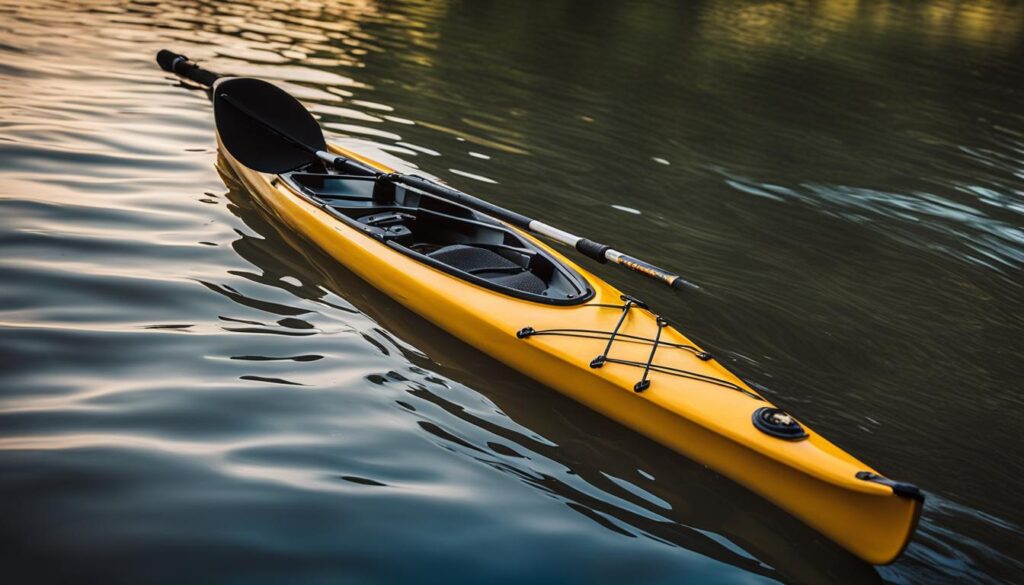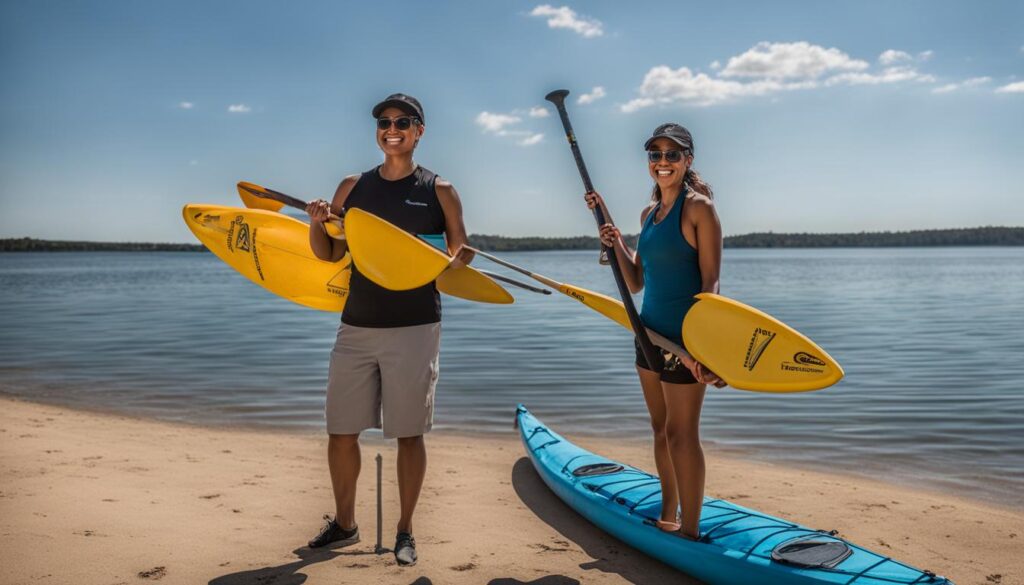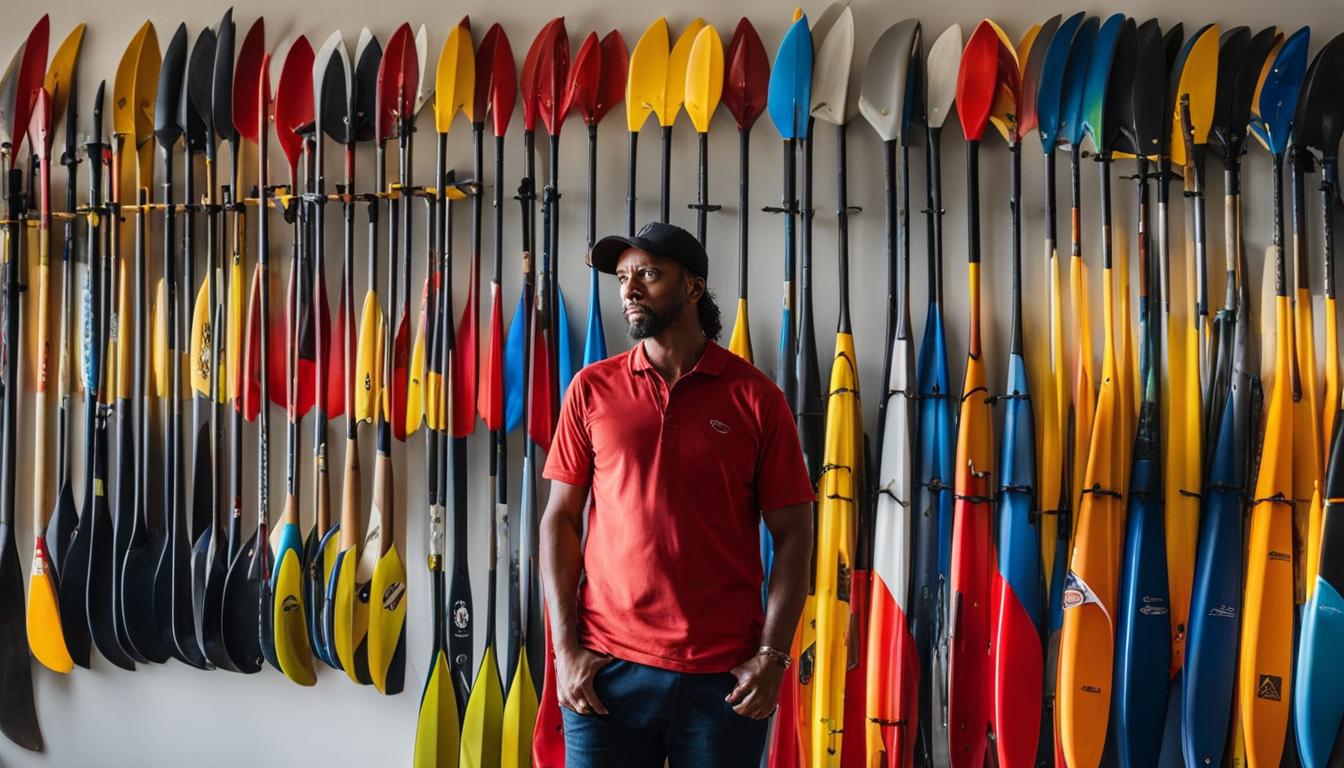Welcome to our comprehensive guide on choosing the right kayak paddle. Whether you’re a seasoned paddler or just starting out, selecting the perfect paddle is essential for a smooth and enjoyable experience on the water. With so many options available, it can be overwhelming to know where to begin. That’s why we’ve put together this handy buying guide to help you navigate through the important factors to consider when selecting your next kayak paddle.
Key Takeaways:
- Understanding the key factors in choosing a kayak paddle is crucial for an optimized paddling experience.
- Consider the paddle blade shape, construction materials, feathering options, paddle length, and shaft design.
- Blade shape affects paddling style, with high angle, low angle, wing, dihedral, and Greenland options available.
- Construction materials vary in terms of weight, durability, and performance, including aluminum, plastic, carbon fiber, fiberglass, and wood.
- Feathering and ferrule systems provide options for adjusting the angle of the paddle blades.
- Choose between one-piece or two/multi-piece paddles for rigidity and portability.
- Shaft design includes options for bent or straight shafts to suit individual comfort and ergonomics.
- Proper paddle sizing is essential for efficient and comfortable paddling.
Different Kayak Paddle Blade Shapes
When it comes to choosing a kayak paddle, one of the key factors to consider is the shape of the paddle blade. The blade shape can greatly impact your paddling performance and efficiency. Here, we will explore the different types of blade shapes and their suitability for various kayaking styles and conditions.
High-Performance Kayak Paddles
High-performance kayak paddles are designed for those who want maximum power and speed. These paddles feature a high-angle blade shape, which means the blade is positioned more vertically during the stroke. This allows for a more aggressive and powerful stroke, making it ideal for racing or whitewater paddling. The high angle of the blade ensures efficient power transfer and quick acceleration.
Adjustable Kayak Paddles
For those looking for versatility, adjustable kayak paddles are a great option. These paddles typically have a blade that can be adjusted to either a high or low angle position, depending on your preference and paddling style. This allows you to switch between a more aggressive stroke for high-performance paddling and a more relaxed stroke for touring or recreational paddling. Adjustable paddles are a popular choice for kayakers who enjoy a variety of paddling experiences.
Paddle Blade Shape Guide
When choosing a paddle blade shape, it’s important to consider your paddling style, the type of water you’ll be paddling in, and your personal preferences. Here is a summary of the different blade shapes:
| Blade Shape | Suitable For |
|---|---|
| High Angle | Racing, whitewater paddling |
| Low Angle | Touring, recreational paddling |
| Wing-Shaped | Racing, speed-oriented paddling |
| Dihedral | Minimizing flutter, better water catch |
| Greenland | Versatile, kayak touring |
Understanding the different blade shapes and their advantages will help you choose the right paddle for your kayaking adventures. Whether you’re seeking speed, versatility, or optimal efficiency, there’s a blade shape out there to suit your needs.

Kayak Paddle Construction Materials
When choosing a kayak paddle, one of the key factors to consider is the construction material. The material used in the paddle affects its weight, durability, and performance. Different materials offer unique advantages and disadvantages, so it’s essential to choose the right one based on your preferences and paddling needs.
Lightweight paddles for kayakers
For kayakers looking for a lightweight option, carbon fiber paddles are an excellent choice. Carbon fiber is known for its strength and stiffness, allowing for efficient strokes and reduced fatigue during long paddling sessions. These paddles are also highly durable, making them suitable for various water conditions.
Another lightweight option is fiberglass paddles. While not as light as carbon fiber, they offer a good balance between weight, durability, and affordability. Fiberglass paddles provide excellent performance and are a popular choice among recreational paddlers and touring kayakers.
Paddle materials and their impact
Aluminum paddles are the most affordable option, but they tend to be heavier. They are commonly used as entry-level paddles or for recreational purposes. Plastic paddles are also budget-friendly and durable, but they have more flex, resulting in less efficient strokes compared to carbon fiber or fiberglass.
Wooden paddles offer a unique combination of flexibility, warmth, and aesthetic appeal. They require more upkeep than other materials, but many paddlers appreciate the natural feel and craftsmanship that wooden paddles provide. They are popular among traditional paddlers and those who value the connection to nature.
Overall, the choice of paddle construction material depends on your priorities, whether it’s lightweight for long tours, durability for rough conditions, or the distinct feel of wooden paddles. Consider your paddling style, preferences, and budget when deciding on the construction material that best suits your needs.
| Paddle Material | Weight | Durability | Performance | Price |
|---|---|---|---|---|
| Carbon Fiber | Lightweight | High | Excellent | Expensive |
| Fiberglass | Lightweight to moderate | High | Very good | Moderate |
| Aluminum | Heavy | Moderate | Good | Affordable |
| Plastic | Lightweight | High | Fair | Affordable |
| Wood | Moderate | Moderate | Good | Moderate |
Feathering and Ferrule Systems
Adjustable kayak paddles offer the flexibility to customize your paddling experience to your preferences and the specific conditions you encounter on the water. One important feature to consider is the feathering and ferrule system of the paddle. Feathering refers to the angle at which the kayak paddle blades are offset from each other. This angle can be adjusted to optimize your stroke efficiency and reduce wind resistance.
Feathered paddles are commonly used in open water paddling, where minimizing wind resistance is essential for maintaining speed and stability. By adjusting the feathering angle, you can find the right balance between power and control. Some adjustable kayak paddles come with ferrule systems that allow you to change the feathering angle on the go, providing even greater versatility.
When choosing between feathered and unfeathered paddles, consider your paddling style, the type of water you will be paddling in, and your personal comfort. Feathered paddles are ideal for experienced paddlers who prioritize speed and efficiency, while unfeathered paddles are more suitable for beginners or those who prefer a more intuitive and natural stroke.
| Pros of Feathered Paddles | Cons of Feathered Paddles |
|---|---|
| Reduced wind resistance for open water paddling | Requires adjustment to find the ideal feathering angle |
| Greater stroke efficiency for experienced paddlers | May feel unfamiliar or awkward for beginners |
| Improved control in windy conditions | Can cause strain or discomfort if the feathering angle is not properly set |
Ultimately, the decision between feathered and unfeathered paddles comes down to personal preference and the specific demands of your paddling adventures. Adjustable kayak paddles with ferrule systems offer the best of both worlds, allowing you to experiment and find the feathering angle that works best for you. With the right paddle, you can enhance your paddling performance and enjoy a more comfortable and efficient time on the water.
One-Piece or Two/Multi-Piece Paddle
When it comes to choosing a kayak paddle, one important decision you’ll need to make is whether to go with a one-piece or two/multi-piece paddle. Each option has its own advantages and considerations, so let’s take a closer look at what you need to know.
The Benefits of a One-Piece Paddle
If you value rigidity and performance, a one-piece paddle may be the best choice for you. These paddles are made from a single shaft and blade, which means they offer excellent power transfer and responsiveness in the water. With no joints or connections, they’re also lighter and more durable than their multi-piece counterparts.
Additionally, one-piece paddles tend to have a more solid feel and can provide a better connection between you and the water. This can be especially important if you’re an experienced paddler or if you’re planning to embark on longer trips or more challenging paddling adventures.
The Advantages of Two/Multi-Piece Paddles
If portability and convenience are your top priorities, a two/multi-piece paddle might be the way to go. These paddles are designed with a shaft that can be separated into two or more pieces, making them easy to transport and store in smaller spaces. They’re a great option if you frequently travel with your kayak or have limited storage capacity.
While two/multi-piece paddles may not offer the same level of rigidity as one-piece paddles, advancements in technology have improved their performance over the years. Many paddles now feature secure and reliable connection systems that minimize play and ensure a solid feel while paddling.
 |
 |
|---|---|
| One-Piece Paddle | Two/Multi-Piece Paddle |
| ✓ Lightweight | ✓ Portable |
| ✓ Stiff and responsive | ✓ Convenient storage |
| ✓ Durable | ✓ Easy to transport |
Ultimately, the choice between a one-piece or two/multi-piece paddle will depend on your personal preferences and priorities. Consider factors such as the type of paddling you’ll be doing, your storage capabilities, and how important rigidity and performance are to you. By understanding the benefits and considerations of each option, you can make an informed decision and choose the paddle that best suits your needs.
Bent and Straight Shaft Kayak Paddles
When it comes to choosing a kayak paddle, one important factor to consider is the shaft design. Kayak paddles can have a bent or straight shaft, each with its own advantages. The decision between the two ultimately depends on your paddling style, comfort, and personal preference.
A bent shaft paddle offers a more ergonomic wrist position, which can be beneficial for long-distance paddlers, those with wrist or shoulder issues, or those planning multi-day trips. The bent design helps to align your wrist and arm, reducing strain and fatigue during extended periods of paddling. It allows for a more natural and comfortable grip, promoting a smooth and efficient stroke.
On the other hand, a straight shaft paddle is the more traditional option and is widely used by kayakers of all levels. It provides a familiar grip and is generally easier to control. Many paddlers find the straight shaft paddle to be more versatile, as it allows for various hand positions and grip adjustments. It’s a great choice for recreational paddlers or those who prefer a more traditional feel.
| Bent Shaft Kayak Paddle | Straight Shaft Kayak Paddle | |
|---|---|---|
| Advantages | – Ergonomic wrist position | – Familiar and versatile grip |
| Best Suited For | – Long-distance paddlers | – Recreational paddlers |
| Recommended For | – Paddlers with wrist or shoulder issues | – Those who prefer a traditional feel |
Ultimately, the choice between a bent and straight shaft kayak paddle comes down to personal preference. Consider trying both designs to see which one feels more comfortable and natural for your paddling style and body. Remember, selecting a paddle that provides ergonomic comfort is essential for enjoying your time on the water and preventing discomfort or injury.
Kayak Paddle Sizing Guide
Choosing the right paddle length is essential for a comfortable and efficient paddling experience. The correct paddle size will allow you to maintain proper form, maximize power, and prevent unnecessary strain on your body. To help you select the ideal paddle length, consider the following factors:
Torso Length
Your torso length plays a significant role in determining the appropriate paddle size. Measure your torso length from your seat to the tip of your nose while sitting upright with your legs extended. This measurement will help you determine the optimal paddle length for your body.
Kayak Width
The width of your kayak also influences the paddle length you should use. A wider kayak requires a longer paddle to reach the water comfortably and facilitate a more effective stroke. Consult the manufacturer’s guidelines or paddle length charts to find the recommended paddle length based on your kayak’s width.
Paddling Style
Your paddling style and the type of kayaking you intend to do will also influence the paddle length that suits you best. Different paddling techniques, such as high-angle or low-angle strokes, will require different paddle lengths. High-angle strokes, which are more vertical, will generally require a shorter paddle. Low-angle strokes, which are more horizontal and relaxed, will typically require a longer paddle. Consider your preferred paddling style when selecting your paddle length.
By considering your torso length, kayak width, and paddling style, you can determine the appropriate paddle length that will enhance your performance and comfort on the water. Remember to test different paddle lengths if possible and consult with experienced paddlers or professionals for further guidance.
| Paddle Length (inches) | Torso Length (inches) | Kayak Width (inches) | Paddling Style |
|---|---|---|---|
| 210-220 | 26-28 | 20-22 | High-angle |
| 220-230 | 28-30 | 22-24 | High-angle |
| 230-240 | 30-32 | 24-26 | High-angle |
| 240-250 | 32-34 | 26-28 | High-angle |
| 250-260 | 34-36 | 28-30 | High-angle |
Conclusion
Now that you have explored the key factors in choosing the right kayak paddle, you are well-equipped to make an informed decision. Remember, different paddling styles require different paddles. If you enjoy racing or whitewater adventures, opt for high-performance paddles with wing-shaped blades for maximum power. For touring or recreational paddling, low angle paddles with dihedral blades offer a more relaxed stroke.
Consider the water type you will be paddling in, as it can greatly impact your paddle selection. Open water paddling may require feathered paddles to reduce wind resistance, while calm rivers or lakes may benefit from unfeathered paddles. Coastal or rough water conditions call for durable materials like carbon fiber or fiberglass, whereas wooden paddles are a great choice for those who appreciate aesthetics and flexibility.
Always ensure that you choose the right paddle length based on your kayak width and torso length. Longer paddles are ideal for wider kayaks, allowing you to comfortably reach the water. Lastly, don’t forget to consider your comfort and ergonomic needs. If you paddle for long distances or have wrist or shoulder issues, go for a bent shaft paddle for a more comfortable grip.
By selecting the right kayak paddle that suits your specific kayaking style and the type of water you’ll be paddling in, you’ll enhance your performance, comfort, and overall enjoyment on the water. So get out there, choose your perfect paddle, and embark on your next kayaking adventure!
FAQ
What factors should I consider when choosing a kayak paddle?
When choosing a kayak paddle, consider factors such as blade shape, construction materials, feathering options, paddle length, and shaft design.
What blade shape should I choose for my kayak paddle?
The blade shape you choose depends on your paddling style. High angle blades provide more power and are suitable for racing and whitewater paddling, while low angle blades offer a more relaxed stroke for touring and recreational paddling. Wing-shaped blades are ideal for racers, dihedral blades minimize flutter, and Greenland paddles offer versatility for kayak touring.
What construction materials are available for kayak paddles?
Kayak paddles can be made of aluminum, plastic, carbon fiber, fiberglass, or wood. Each material has its own weight, durability, and performance characteristics, so consider your preferences and budget when making a selection.
What is feathering and why is it important in a kayak paddle?
Feathering refers to the angle of the paddle blades. Feathered paddles reduce wind resistance, making them ideal for open water paddling. Some paddles come with ferrule systems that allow you to adjust the feathering angle. Consider your paddling style, conditions, and wrist comfort when choosing between feathered and unfeathered paddles.
Should I choose a one-piece or two/multi-piece kayak paddle?
One-piece paddles are stiffer and lighter but less portable, while two/multi-piece paddles are easier to transport and store but may have some play or flexibility in the joint. Consider your preference for rigidity and portability when deciding between one-piece and two/multi-piece paddles.
What are the benefits of a bent shaft kayak paddle?
Bent shaft paddles provide a more ergonomic wrist position and are suitable for long-distance paddlers, those with wrist or shoulder issues, and multi-day trips. Straight shaft paddles are more common and offer a traditional grip. Try both shaft styles to determine which feels more comfortable for your paddling style and body.
How do I choose the right size kayak paddle?
To choose the right size kayak paddle, consider the width of your kayak, your torso length, and the type of paddling you will be doing. A wider kayak may require a longer paddle to reach the water comfortably. Measure your torso length or use the paddle length chart to determine the ideal paddle size for your body and paddling activities.
What should I consider when selecting a kayak paddle?
When selecting a kayak paddle, consider factors such as blade shape, construction materials, feathering options, paddle length, and shaft design. Each factor can impact the performance, comfort, and efficiency of your paddling experience. By understanding these factors and selecting a paddle that aligns with your paddling style and preferences, you can enhance your enjoyment on the water and optimize your paddling experience.





